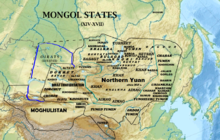 Territory of the Khalkha Mongols during the early Northern Yuan period. | |
| Regions with significant populations | |
|---|---|
| 2,659,985[1] | |
| Languages | |
| Halh Mongolian | |
| Religion | |
| Predominantly Buddhism (92.7%), Mongolian Shamanism (4.0%) and minority Eastern Orthodox Church, Protestantism (2.3%)[2] | |
| Related ethnic groups | |
| Other Mongol groups (Buryats, Khotgoid, Oirats) | |
The Khalkha (/ˈkælkə, ˈkɑːlkə/; Mongolian: Халх ᠬᠠᠯᠬᠠ [ˈχa̠ɬχ]) have been the largest subgroup of the Mongols[3] in modern Mongolia since the 15th century. The Khalkha, together with Chahars, Ordos and Tumed, were directly ruled by Borjigin khans until the 20th century; unlike the Oirats, who were ruled by Dzungar nobles or the Khorchins, who were ruled by Qasar's descendants.
The two original major Khalkha groups were ruled by the direct male line descendants of Dayan Khan. The Baarin, Khongirad, Jaruud, Bayaud and the O'zeed (Ujeed) became Dayan Khan's fifth son Achibolod's subjects, thus formed the Southern Five Halhs. Seven northern Khalkha otogs: 1) Jalairs, Olkhonud; 2) Besut, Iljigin; 3) Gorlos, Keregut; 4) Khuree, Khoroo, Tsookhor; 5) Khukhuid, Khatagin; 6) Tanghut, Sartuul; 7) Uriankhai[4] became Dayan Khan's youngest (could be third) son Geresenje's (Mongolian: Гэрсэне Жалайр Хан) subjects. Khotogoids are close in culture and language to the Khalkha Mongols.[5]
There were also numerous direct descendants of Genghis Khan who had formed the ruling class of the Khalkha Mongols prior to the 20th century, but they were and still also regarded as Khalkha Mongols rather than belonging to a special unit.
The Thirteen Khalkhas of the Far North are the major subethnic group of the independent state of Mongolia. They number 2,659,985 (83.8% of Mongolia's population).
The Khalkha or Halh dialect is the standard written language of Mongolia.[6]
- ^ "2020 POPULATION AND HOUSING CENSUS OF MONGOLIA /summary/".
- ^ "2020 Population and housing census of Mongolia". National Statistical Office of Mongolia. Archived from the original on 17 August 2021. Retrieved 22 November 2021.
- ^ Khalkha
- ^ Очир А. (2016). Монгольские этнонимы: вопросы происхождения и этнического состава монгольских народов. Элиста: КИГИ РАН. pp. 188–192. ISBN 978-5-903833-93-1. д.и.н. Э. П. Бакаева, д.и.н. К. В. Орлова
- ^ Очир А. (2016). Монгольские этнонимы: вопросы происхождения и этнического состава монгольских народов. Элиста: КИГИ РАН. p. 222. ISBN 978-5-903833-93-1. д.и.н. Э. П. Бакаева, д.и.н. К. В. Орлова
- ^ C. P. Atwood Encyclopedia of Mongolia and the Mongol Empire, Khalkha